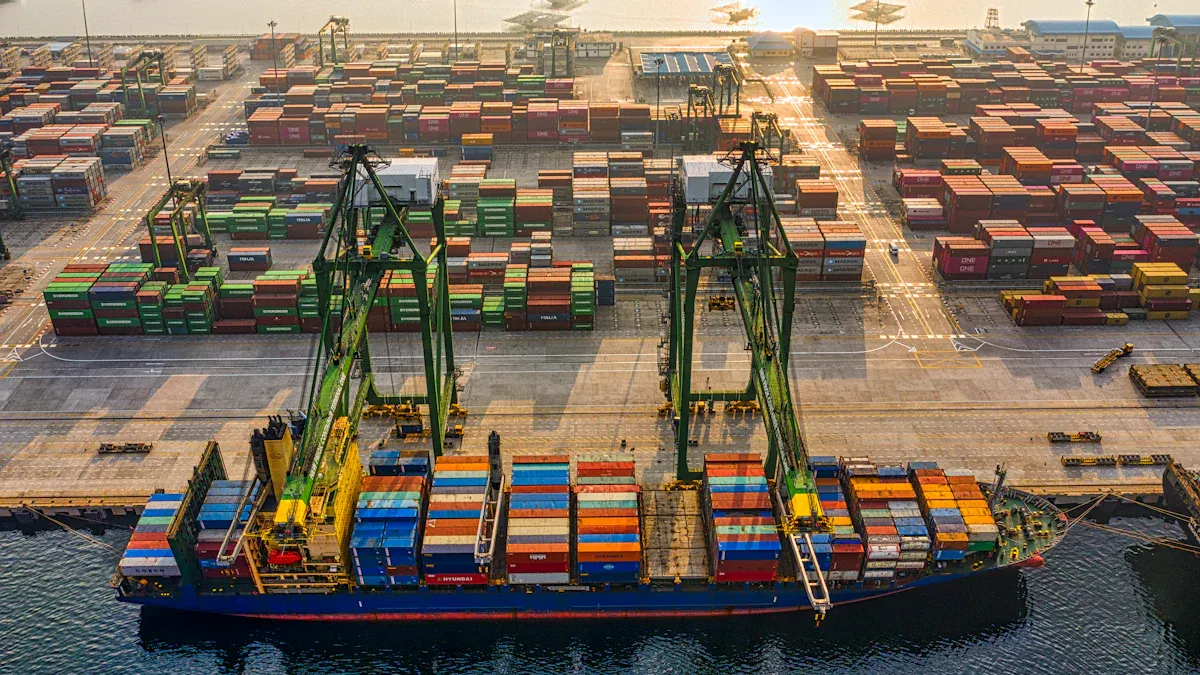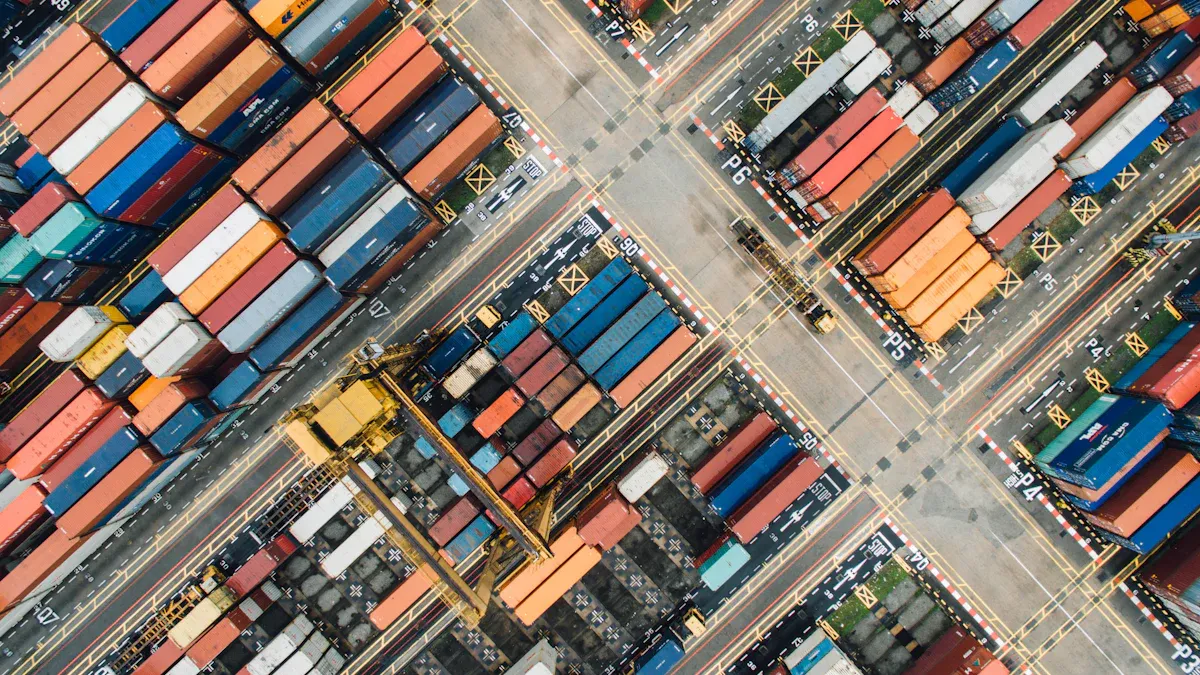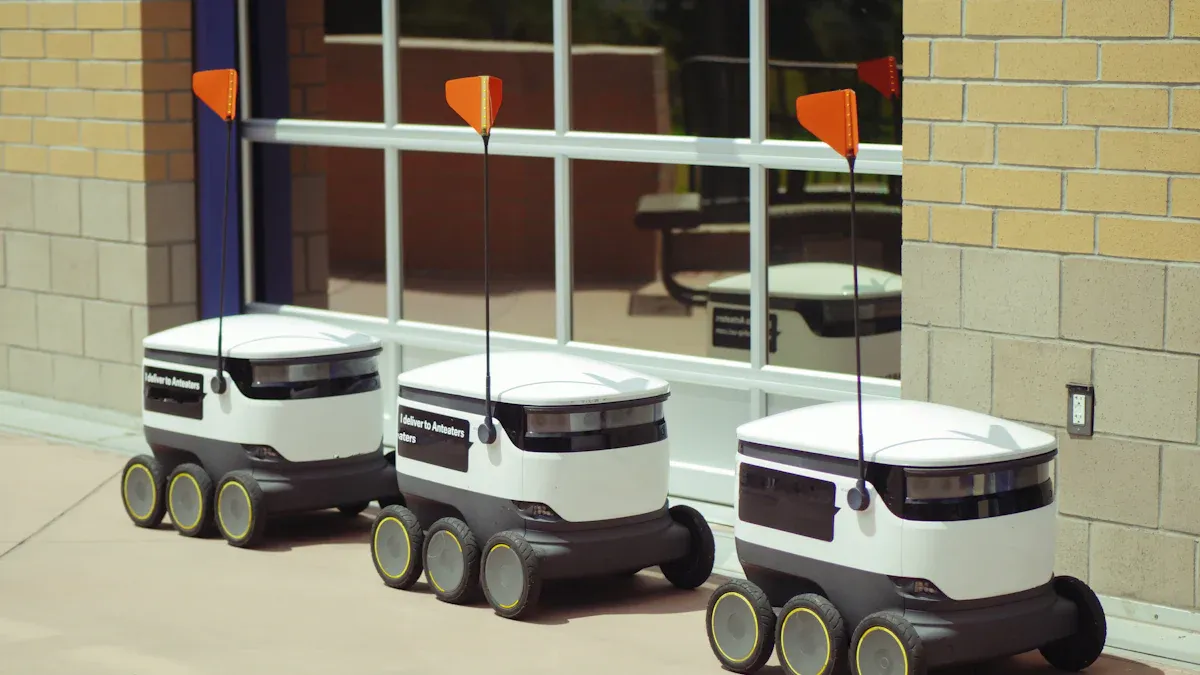The Future of Offshore Warehousing and Logistics Operations

By 2025, overseas warehouse shipping will be key to world trade. It helps businesses operate more efficiently and save money. Tools like IoT track energy use and support green energy initiatives. New regulations are changing shipping routes to emphasize clean practices. Companies adopting these strategies will stay ahead in the shipping industry.
Key Takeaways
Use AI and IoT to improve supply chain work. These tools help track stock and guess future needs, making things run smoother.
Use blockchain for safer shipping. It keeps secure records, stops fraud, and builds trust with others.
Use renewable energy in warehouses to save money and cut pollution. This helps the planet and meets the need for eco-friendly shipping.
Emerging Technologies Shaping Offshore Warehousing in 2025

AI and IoT for Better Supply Chain Management
AI and IoT are changing offshore warehouse management. These tools help track and control tasks instantly. IoT sensors check stock levels, energy use, and machine health. AI studies this data to predict needs and improve systems. For example, it helps plan better to avoid too much or too little stock.
Global trade is growing fast, boosting the logistics market. Asian and Latin American countries are improving transport systems. In the U.S., smart warehouses and delivery systems are now vital. IoT and RFID make tracking easier, which is key for online shopping. These tools keep supply chains fast and eco-friendly.
Examples show how AI and IoT help:
One study showed how farmers used these tools during COVID-19 to share resources better.
Another study showed AI makes supply chains faster and solves ethical issues.
Blockchain for Safer Overseas Shipping
Blockchain is making overseas shipping safer and clearer. It keeps a secure digital record of every deal. This lets you track shipments live and check they’re real. For example, sending shipping papers now takes seconds, not days.
Blockchain cuts fraud by 40% with safe document storage. Companies like FedEx support it to improve global shipping. Using blockchain builds trust with partners and customers while making work easier.
Automation and Robots in Warehouses
Automation and robots are changing warehouse work. Machines now do tasks like sorting, picking, and packing. This lowers mistakes and speeds up orders. Robots with AI can move around, grab items, and restock shelves.
These tools save time and cut labor costs. They also help when there aren’t enough workers. With automation, you can focus on big tasks while robots do the small ones.
Digital Twins and Teamwork with Machines
Digital twins are virtual copies of real warehouses. They let you test changes before doing them. For example, you can try new setups to find problems early. This helps you make better choices and work faster.
People and machines work together with this tech. Workers use AR tools to see and use digital twins. This teamwork makes warehouses run their best.
By using these new technologies, you can stay ahead in offshore warehousing and logistics.
Sustainability and Green Logistics in Offshore Operations

Warehouses Using Renewable Energy
Offshore warehouses can use renewable energy to work better. Energy from wind, sun, and waves replaces fossil fuels. This lowers costs and helps the planet. For example, the offshore energy storage market will grow fast. It is expected to rise from $3.64 billion in 2023 to $12.5 billion by 2032. This is a yearly growth rate of 14.71%. More people want clean energy, making it key for logistics.
Using renewable energy also helps cut carbon emissions. Green strategies make supply chains cleaner and more efficient. Warehouses with LED lights and smart energy systems save energy. These tools lower costs and fight climate change.
Shipping with Less Carbon
Shipping without carbon is important for green logistics. Scope 3 emissions are the biggest part of a company’s carbon output. You can lower these by funding insetting projects. These projects improve your operations and reduce outside offsets. This shows you care about the environment.
Companies use cleaner fuels and better shipping routes to cut emissions. They also use energy-saving ships to work smarter. These steps help the planet and make shipping faster. By focusing on carbon-free shipping, you support eco-friendly logistics.
Reusing and Recycling in Supply Chains
Circular supply chains help reduce waste in offshore work. Reusing and recycling materials saves resources and protects nature. Important steps include port facilities, waste systems, and strict rules. These ensure waste is handled properly and recycled.
Evidence Type | What It Does |
|---|---|
Port Facilities | Reduce ship waste and recycle materials. |
Waste Systems | Handle ship waste and ensure proper recycling. |
Rules and Laws | Support recycling and stop waste dumping in oceans. |
Turning waste into useful items helps save money and resources. For example, waste systems follow rules and improve efficiency. Circular supply chains make logistics greener and more cost-effective.
By using renewable energy, carbon-free shipping, and recycling, you lead in sustainability. These green ideas make supply chains cleaner and ready for the future.
Space Optimization and Global Fulfillment Strategies
Multi-Node Warehousing for Faster Overseas Warehouse Shipping
Multi-node warehousing stores goods in different places near customers. This helps deliver orders faster and makes customers happier. Splitting inventory across areas handles more orders easily. It also lowers delays if one location has problems.
You can check how well this works by tracking key numbers. These include customer happiness, inventory turnover, and delivery times. For example:
Metric | What It Shows |
|---|---|
Customer Satisfaction Scores | How happy customers are with delivery speed. |
Inventory Turnover Rate | How fast items are sold and replaced. |
Shipping Cost per Order | How much shipping costs for each order. |
Average Delivery Time | Time it takes for orders to reach customers. |
Perfect Order Rate | Orders delivered complete and on time. |
Using this method improves logistics and meets global shipping needs.
Vertical Storage Solutions for Space Efficiency
Vertical storage uses warehouse height to store more items. This saves space and avoids building new warehouses. It also cuts costs and reduces the need to move locations.
These systems make work faster. Workers can grab items quickly, speeding up orders. They also save energy and lower lighting and cooling costs. Vertical storage supports eco-friendly goals like LEED certifications. By using space wisely, you save money and help the environment.
Data-Driven Inventory Management with JUSDA Warehouses
Real-time inventory tools keep track of stock levels. JUSDA warehouses use smart systems like eVMI and JusLink for accurate data. These tools predict demand and prevent too much or too little stock.
JUSDA’s systems make work clear and easy to manage. For example, smart tech helps pack and pick orders faster. This reduces mistakes and speeds up shipping. Using these tools improves logistics and keeps you ahead in global trade.
Challenges and Solutions in Offshore Logistics
Using Automation to Solve Worker Shortages
Automation helps fix worker shortages in offshore logistics. Machines and smart systems now do tasks like packing and sorting. This means less need for workers and faster work.
Here’s how automation helps:
It makes work faster by up to 25%.
Robots make fewer mistakes and work the same every time.
You can focus on big tasks while machines do small ones.
Using automation builds strong supply chains. It helps handle worker problems and keeps work running smoothly.
Handling Trade Problems from Politics
Politics can cause trade problems that make logistics harder. Learning from past events helps you deal with these issues.
Aspect | Cold War Time | Today’s Trade Issues |
|---|---|---|
Trade between groups | Much lower | Not much different |
Trade shortfall between groups | Bigger than now | Smaller than Cold War times |
Goods trade to GDP ratio | 45% | |
Trade rules | Fewer restrictions | More protection rules |
Today, you need smart plans to handle trade rules and keep things moving. By using new routes and tech, you can avoid problems and stay connected globally.
Stopping Supply Chain Problems with JusLink
Supply chain issues can stop work, but JusLink can help. This smart tool watches your supply chain and manages risks in real time.
JusLink works well in real examples:
A big company used JusLink to plan better and restock faster.
Accuracy went up by 78%, and stock moved quicker.
With JusLink, you can see risks early, manage stock better, and improve logistics. This tool keeps your supply chain safe and working, even during tough times.
Practical Steps for Using New Warehousing Trends
Checking If Your Technology is Ready
It’s important to see if your tools are ready. Compare new tools with old ones to find benefits. Use guides like the Technology Readiness Assessment to check risks and uses. Work with your team to set clear goals for testing tools. This helps everyone know what to expect.
Check your tools often to keep up with changes. For example, automation and 5G are now very useful. Fast internet helps connect automated systems easily. This is important for industries like cars and consumer goods. By planning ahead, you can solve problems like fewer workers and high costs.
Working with JUSDA for Better Logistics
JUSDA gives smart solutions for today’s warehouse needs. They use advanced tools like RFID and WMS to work faster. Their plans fit your needs, whether you work in electronics, cars, or fast-moving goods.
For example, JUSDA’s JusLink tool shows real-time supply chain updates. It cuts costs by 15% and speeds up orders by 25%. These results show how helpful JUSDA’s tools are. By teaming up with JUSDA, you get better tools and a strong network to improve your logistics.
Training Teams for Digital Supply Chains
Teaching your team about digital tools is very important. Start by removing tasks that waste time and automating data work. Combine similar items and include vendors in daily tasks to save time. Train your team to use tools like JUSDA’s eVMI and JusLink for easier inventory work.
Ask your team to watch key numbers like stock levels and order accuracy. This helps them always improve. By giving your team the right skills, you make switching to modern supply chains easier.
The future of offshore warehousing relies on new ideas and being eco-friendly. Tools like AI improve supply chains and green practices help the planet. Using these changes keeps businesses strong and competitive. Working with JUSDA gives custom solutions to improve work and meet market needs.
See Also
Exploring Automation: Advantages of Advanced Manufacturing Warehouses
Transforming Logistics: The Impact of AI on Supply Chains
Navigating the Future: Digital Innovations in Logistics
Unlocking AI's Power: The Future of Logistics Explored
Boosting Warehouse Efficiency: The Role of Robotics in Logistics
